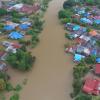
In the last decades, many parts of the world faced an increase in the number of extreme weather events and worsening climatic conditions endangering the livelihood of households in developing countries that rely on their local environment. While various empirical studies have identified key factors of exposure and vulnerability to disaster risk, we still lack a conceptual understanding of how these forces interact and how they impact household decision making.
In this model we develop a dynamic household model, in which households face stochastic environmental hazards, which can lead to a loss of their wealth. To respond to the risk, households can either relocate to a safer area or undertake preventive measures to protect their physical assets. Both actions require material and immaterial resources, which constrain the household's decision. Thereby we allow for several levels of heterogeneity amongst households.
Such a theoretical framework then allows for a more realistic analysis of policy interventions, as the household behavior is derived from their preferences. Compared to empirical behavioral rules, which are in general conditional on the setting the data is collected in, in this model households have an intrinsic motivation to maximize their utility and therefore do react realistically to dramatic environmental changes or policy interventions.
 © Michael Freiberger
© Michael Freiberger
We use our MORIBE modelling framework to formulate the household decision process as a stochastic, dynamic optimization problem. We then use computational numerical methods to obtain to optimal household decision rules before and after policy interventions. Using Monte-Carlo-Simulations we can simulate the long-run outcomes of households and assess the effects of different policy interventions. For more details see the working paper by Freiberger, Hoffmann & Prskawetz (2024) listed below.
Working Paper
Freiberger, M., Hoffmann, R., & Fürnkranz-Prskawetz, A. (2024). Should I stay or should I go: Modelling disaster risk behaviour using a dynamic household level approach. IIASA Working Paper. Laxenburg, Austria: WP-24-010
